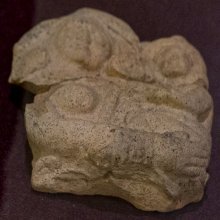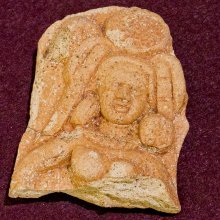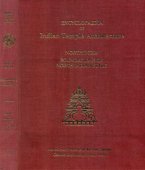Shunga, Śuṅga, Śuṅgā: 13 definitions
Introduction:
Shunga means something in Hinduism, Sanskrit, the history of ancient India, biology. If you want to know the exact meaning, history, etymology or English translation of this term then check out the descriptions on this page. Add your comment or reference to a book if you want to contribute to this summary article.
The Sanskrit terms Śuṅga and Śuṅgā can be transliterated into English as Sunga or Shunga, using the IAST transliteration scheme (?).
Images (photo gallery)
In Hinduism
Purana and Itihasa (epic history)
Source: archive.org: Puranic EncyclopediaŚuṅga (शुङ्ग).—A dynasty. Puṣyamitra was the founder of this dynasty. Puṣyamitra was the military commander of Bṛhadaśva, the last King of the Maurya dynasty. It was after killing Bṛhadaśva that Puṣyamitra founded this independent dynasty. The Kings who belonged to this dynasty, namely Puṣyamitra, Vasujyeṣṭha, Vasumitra, Antaka, Pulindaka, Vajramitra, Samābhāga and Devabhūmi ruled for 112 years. (Matsya Purāṇa, Chapter 272, Verses 26-31).
Source: Cologne Digital Sanskrit Dictionaries: The Purana Index1a) Śuṅga (शुङ्ग).—Kings ten in number, commencing with Puṣyamitra: Ruled the earth for more than hundred years the Matsya-purāṇa eight of them are mentioned, Pruṣyamitra, Vasujyeṣṭha, Vasumitra, Antaka, Pulindaka, Vajramitra, Samābhāga, and Devabhūmi; ruled after the Mauryas.*
- * Bhāgavata-purāṇa XII. 1. 18; Brahmāṇḍa-purāṇa III. 74. 149 and 155; Matsya-purāṇa 272. 26-32; Vāyu-purāṇa 99. 336; Viṣṇu-purāṇa IV. 24. 33, 37.
1b) A tribe.*
- * Matsya-purāṇa 163. 66.

The Purana (पुराण, purāṇas) refers to Sanskrit literature preserving ancient India’s vast cultural history, including historical legends, religious ceremonies, various arts and sciences. The eighteen mahapuranas total over 400,000 shlokas (metrical couplets) and date to at least several centuries BCE.
Ayurveda (science of life)
Toxicology (Study and Treatment of poison)
Source: Shodhganga: Kasyapa Samhita—Text on Visha ChikitsaŚuṅga (शुङ्ग) (white) is the name of an ingredient used in the treatment of Maṇḍalī-snake-bites, according to the Kāśyapa Saṃhitā: an ancient Sanskrit text from the Pāñcarātra tradition dealing with both Tantra and Viṣacikitsā—an important topic from Āyurveda which deals with the study of Toxicology (Viṣavidyā or Sarpavidyā).—A number of different permutation and combination of herbs are prescribed as Lepa and Pāna for removing the poison of Maṇḍalī snakes.—According to the Kāśyapasaṃhitā verse 9.79cd: “A decoction of Kāśmarya, Jīvaka and Jīvakarṣabha, Nyagrodha, white Śuṅga, Mañjiṣṭhā and Madhuka given as drink can quell the poison”.

Āyurveda (आयुर्वेद, ayurveda) is a branch of Indian science dealing with medicine, herbalism, taxology, anatomy, surgery, alchemy and related topics. Traditional practice of Āyurveda in ancient India dates back to at least the first millenium BC. Literature is commonly written in Sanskrit using various poetic metres.
India history and geography
Source: Shodhganga: Elements of Art and Architecture in the Trtiyakhanda of the Visnudharmottarapurana (history)Shunga refers to a certain period in the history of Indian Art.—The chronological order of the development of Indian Art as stated in The Heritage of Indian Art is as follows—[...] 6. The Śuṅga period belongs to 185-72 B.C. and this period consists of the stupas of Bharhut and Sanchi with stone railings and gateways.

The history of India traces the identification of countries, villages, towns and other regions of India, as well as mythology, zoology, royal dynasties, rulers, tribes, local festivities and traditions and regional languages. Ancient India enjoyed religious freedom and encourages the path of Dharma, a concept common to Buddhism, Hinduism, and Jainism.
Biology (plants and animals)
Source: Google Books: CRC World Dictionary (Regional names)1) Sunga in Tanzania is the name of a plant defined with Emilia coccinea in various botanical sources. This page contains potential references in Ayurveda, modern medicine, and other folk traditions or local practices It has the synonym Cacalia sagittata Willd. (among others).
2) Sunga is also identified with Launaea cornuta It has the synonym Lactuca farinentula (Chiov.) Cufod. (etc.).
3) Sunga is also identified with Sonchus luxurians It has the synonym Sonchus oliveri-hiernii Boulos var. luxurians (R.E. Fr.) L. Boulos (etc.).
Example references for further research on medicinal uses or toxicity (see latin names for full list):
· Flora of Tropical Africa (1877)
· Mém. (1910)
· Taxon (1975)
· Beitrag zur Flora Aethiopiens (1867)
· Fieldiana, Botany (1976)
· Nomenclator Botanicus (1821)
If you are looking for specific details regarding Sunga, for example chemical composition, side effects, health benefits, extract dosage, diet and recipes, pregnancy safety, have a look at these references.

This sections includes definitions from the five kingdoms of living things: Animals, Plants, Fungi, Protists and Monera. It will include both the official binomial nomenclature (scientific names usually in Latin) as well as regional spellings and variants.
Languages of India and abroad
Sanskrit dictionary
Source: DDSA: The practical Sanskrit-English dictionaryŚuṅga (शुङ्ग).—1 The (Indian) fig tree.
2) The hog-plum.
3) The awn of corn.
4) A sage; Uṇādi-sūtra 1.113.
-ṅgam 1 The sheath of a bud (opp. to mūla); तत्रैतच्छुङ्गमुत्पतितं सोम्य विजानीहि नेदममूलं भविष्यतीति (tatraitacchuṅgamutpatitaṃ somya vijānīhi nedamamūlaṃ bhaviṣyatīti) Ch. Up.6.8.5.
Derivable forms: śuṅgaḥ (शुङ्गः).
--- OR ---
Śuṅgā (शुङ्गा).—
1) The sheath of a young bud.
2) The awn of barley or corn.
3) The waved-leaf fig.
Source: Cologne Digital Sanskrit Dictionaries: Shabda-Sagara Sanskrit-English DictionaryŚuṅga (शुङ्ग).—m.
(-ṅgaḥ) 1. The Indian-fig tree, (Ficus Indica.) 2. The hog-plum, (Spondias mangifera.) f.
(-ṅgā) 1. The sheath or calyx of a young bud. 2. The waved-leaf fig. 3. The awn of barley, &c. E. śam to rest or pacify, aff. gac; form irr.
Source: Cologne Digital Sanskrit Dictionaries: Benfey Sanskrit-English DictionaryŚuṅga (शुङ्ग).—I. m. The Indian figtree, Windischmann, Sankara, 179. Ii. f. gā, The sheath of a young bud (cf. Atharv.-Ved. viii. 7, 4, at the end of a comp. adj.).
Source: Cologne Digital Sanskrit Dictionaries: Cappeller Sanskrit-English DictionaryŚuṅga (शुङ्ग).—[masculine] [Name] of a dynasty of kings; [neuter] the sheath or calyx of a young bud (also śuṅgā [feminine]); effect; [feminine] śuṅgā & ī also [Name] of the mother of Garuḍa.
Source: Cologne Digital Sanskrit Dictionaries: Aufrecht Catalogus CatalogorumŚuṅga (शुङ्ग) as mentioned in Aufrecht’s Catalogus Catalogorum:—pl. Quoted in Lāṭyāyanaśrautasūtra, 4, 6, 20.
Source: Cologne Digital Sanskrit Dictionaries: Monier-Williams Sanskrit-English Dictionary1) Śuṅga (शुङ्ग):—a m. (etymology doubtful) the Indian fig-tree (= vaṭa), [cf. Lexicographers, esp. such as amarasiṃha, halāyudha, hemacandra, etc.]
2) Ficus Infectoria, [cf. Lexicographers, esp. such as amarasiṃha, halāyudha, hemacandra, etc.]
3) Spondias Mangifera, [cf. Lexicographers, esp. such as amarasiṃha, halāyudha, hemacandra, etc.]
4) the awn of corn, [cf. Lexicographers, esp. such as amarasiṃha, halāyudha, hemacandra, etc.]
5) the sheath or calyx of a bud, [cf. Lexicographers, esp. such as amarasiṃha, halāyudha, hemacandra, etc.]
6) Name of a man ([plural] his descendants), [Pravara texts] (cf. [Pāṇini 4-1, 117])
7) [plural] Name of a dynasty which succeeded the Mauryas (sg. a king of the Ś° dyn°), [Purāṇa]
8) Śuṅgā (शुङ्गा):—a f. See below
9) Śuṅga (शुङ्ग):—[from śuṅgā] b n. the sheath or calyx of a bud, ([figuratively]) effect (opp. to mūla, ‘cause’), [Chāndogya-upaniṣad]
10) [v.s. ...] Ficus Infectoria, [cf. Lexicographers, esp. such as amarasiṃha, halāyudha, hemacandra, etc.]
11) Śuṅgā (शुङ्गा):—b f. the sheath or calyx of a young bud ([especially] of a fig-tree), [Gṛhya-sūtra; Suśruta]
12) the awn of barley etc., a bristle, [cf. Lexicographers, esp. such as amarasiṃha, halāyudha, hemacandra, etc.]
13) the waved-leaf fig-tree, [Horace H. Wilson]
14) Name of the mother of Garuḍa, [Suparṇādhyāya]
Source: Cologne Digital Sanskrit Dictionaries: Yates Sanskrit-English DictionaryŚuṅga (शुङ्ग):—(ṅgaḥ) 1. m. The Indian fig tree; hog plum. 1. f. Calyx of a bud; waved-leaf fig; awn of barley.
[Sanskrit to German]
Sanskrit, also spelled संस्कृतम् (saṃskṛtam), is an ancient language of India commonly seen as the grandmother of the Indo-European language family (even English!). Closely allied with Prakrit and Pali, Sanskrit is more exhaustive in both grammar and terms and has the most extensive collection of literature in the world, greatly surpassing its sister-languages Greek and Latin.
See also (Relevant definitions)
Starts with: Shunga-pwapwa, Shungabhritya, Shungakarman, Shungarajan.
Ends with: Dantashunga, Ekashunga, Mshunga, Shvetashunga, Shvethashunga, Sitashunga.
Full-text (+40): Shvetashunga, Agnimitra, Shungin, Shungarajan, Shungakarman, Shaungya, Ekashunga, Shaungi, Shaunga, Shungibhuta, Agniveshya, Shunga-pwapwa, Shiru-shungam, Puka sunga, Pushyamitra, Shaungeya, Shaungayani, Andraka, Bhagabhadra, Panr.
Relevant text
Search found 34 books and stories containing Shunga, Śuṅga, Sunga, Śuṅgā; (plurals include: Shungas, Śuṅgas, Sungas, Śuṅgās). You can also click to the full overview containing English textual excerpts. Below are direct links for the most relevant articles:
A Historical Study of Kaushambi (by Nirja Sharma)
Kaushambi during the Shunga Dynasty < [Chapter 2]
Political History of Vatsa < [Chapter 2]
Sculptures from Kaushambi < [Chapter 4]
Stupas in Orissa (Study) (by Meenakshi Chauley)
During the time of Sunga’s < [Chapter 2]
Development of Stupa Architecture in India < [Chapter 3]
Major Stupas at Langudi < [Chapter 4]
Historical Elements in the Matsya Purana (by Chaitali Kadia)
Dynasty of Śuṅga < [Chapter 6 - Human history in the Matsya-Purāṇa]
The Bhagavata Purana (by G. V. Tagare)
Chapter 1 - Dynasties of the Kali Age < [Book 12 - Twelfth Skandha]
Amaravati Art in the Context of Andhra Archaeology (by Sreyashi Ray chowdhuri)
Buddhist sculptural art < [Chapter 5 - Impact of Amarāvatī Art]
Contribution of Amarāvatī Art (Introduction) < [Chapter 5 - Impact of Amarāvatī Art]
Kalidasa the Playwright different from < [July – September, 1999]
Hinduism: The Golden Thread of Indian History < [January – March, 1979]
The Siva Linga: Conceptual, Iconographical and < [January – March, 1996]
Related products





